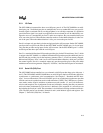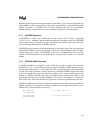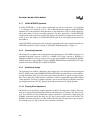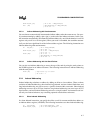
8XC196MC, MD, MH USER’S MANUAL
3-2
Table 3-2 lists the equivalent operand-type names for both C programming and assembly lan-
guage.
3.1.1 BIT Operands
A BIT is a single-bit variable that can have the Boolean values, “true” and “false.” The architec-
ture requires that BITs be addressed as components of BYTEs or WORDs. It does not support the
direct addressing of BITs.
3.1.2 BYTE Operands
A BYTE is an unsigned, 8-bit variable that can take on values from 0 through 255 (2
8
–1). Arith-
metic and relational operators can be applied to BYTE operands, but the result must be interpret-
ed in modulo 256 arithmetic. Logical operations on BYTEs are applied bitwise. Bits within
BYTEs are labeled from 0 to 7; bit 0 is the least-significant bit. There are no alignment restric-
tions for BYTEs, so they may be placed anywhere in the address space.
3.1.3 SHORT-INTEGER Operands
A SHORT-INTEGER is an 8-bit, signed variable that can take on values from –128 (–2
7
) through
+127 (+2
7
–1). Arithmetic operations that generate results outside the range of a SHORT-
INTEGER set the overflow flags in the processor status word (PSW). The numeric result is the
same as the result of the equivalent operation on BYTE variables. There are no alignment restric-
tions on SHORT-INTEGERs, so they may be placed anywhere in the address space.
3.1.4 WORD Operands
A WORD is an unsigned, 16-bit variable that can take on values from 0 through 65,535 (2
16
–1).
Arithmetic and relational operators can be applied to WORD operands, but the result must be in-
terpreted in modulo 65536 arithmetic. Logical operations on WORDs are applied bitwise. Bits
within WORDs are labeled from 0 to 15; bit 0 is the least-significant bit.
Table 3-2. Equivalent Operand Types for Assembly and C Programming Languages
Operand Types Assembly Language Equivalent C Programming Language Equivalent
BYTE BYTE unsigned char
SHORT-INTEGER BYTE char
WORD WORD unsigned int
INTEGER WORD int
DOUBLE-WORD LONG unsigned long
LONG-INTEGER LONG long


















